cooling TOYOTA TUNDRA 2011 2.G Owners Manual
[x] Cancel search | Manufacturer: TOYOTA, Model Year: 2011, Model line: TUNDRA, Model: TOYOTA TUNDRA 2011 2.GPages: 732, PDF Size: 16.65 MB
Page 301 of 732
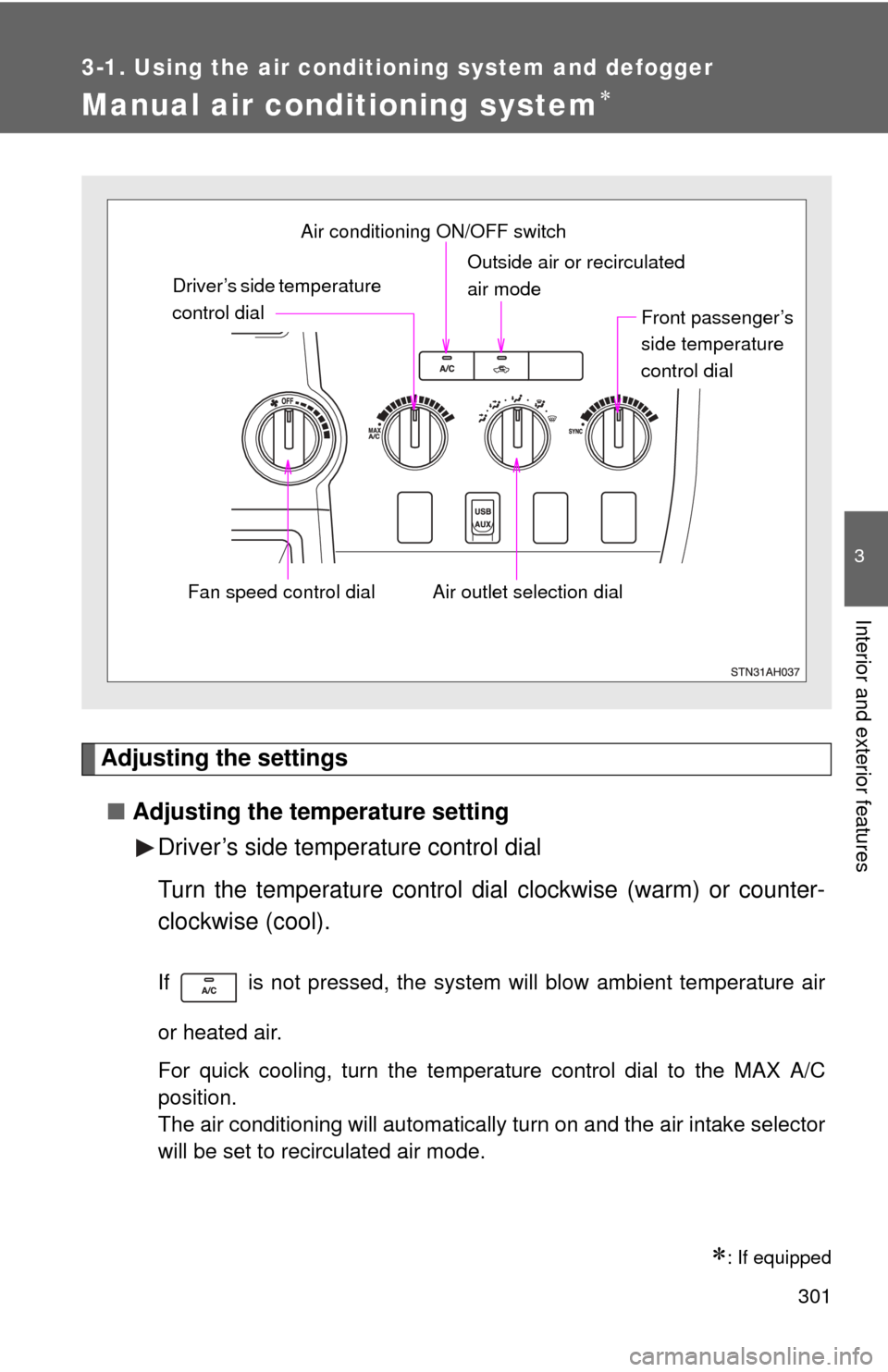
301
3-1. Using the air conditioning system and defogger
3
Interior and exterior features
Manual air conditioning system
Adjusting the settings■ Adjusting the temperature setting
Driver’s side temperature control dial
Turn the temperature control dial clockwise (warm) or counter-
clockwise (cool).
If is not pressed, the system will blow ambient temperature air
or heated air.
For quick cooling, turn the temperature control dial to the MAX A/C
position.
The air conditioning will automatically turn on and the air intake selector
will be set to recirculated air mode.
: If equipped
Outside air or recirculated
air mode
Air outlet selection dial
Air conditioning ON/OFF switch
Driver’s side temperature
control dial
Fan speed control dial
Front passenger’s
side temperature
control dial
Page 530 of 732
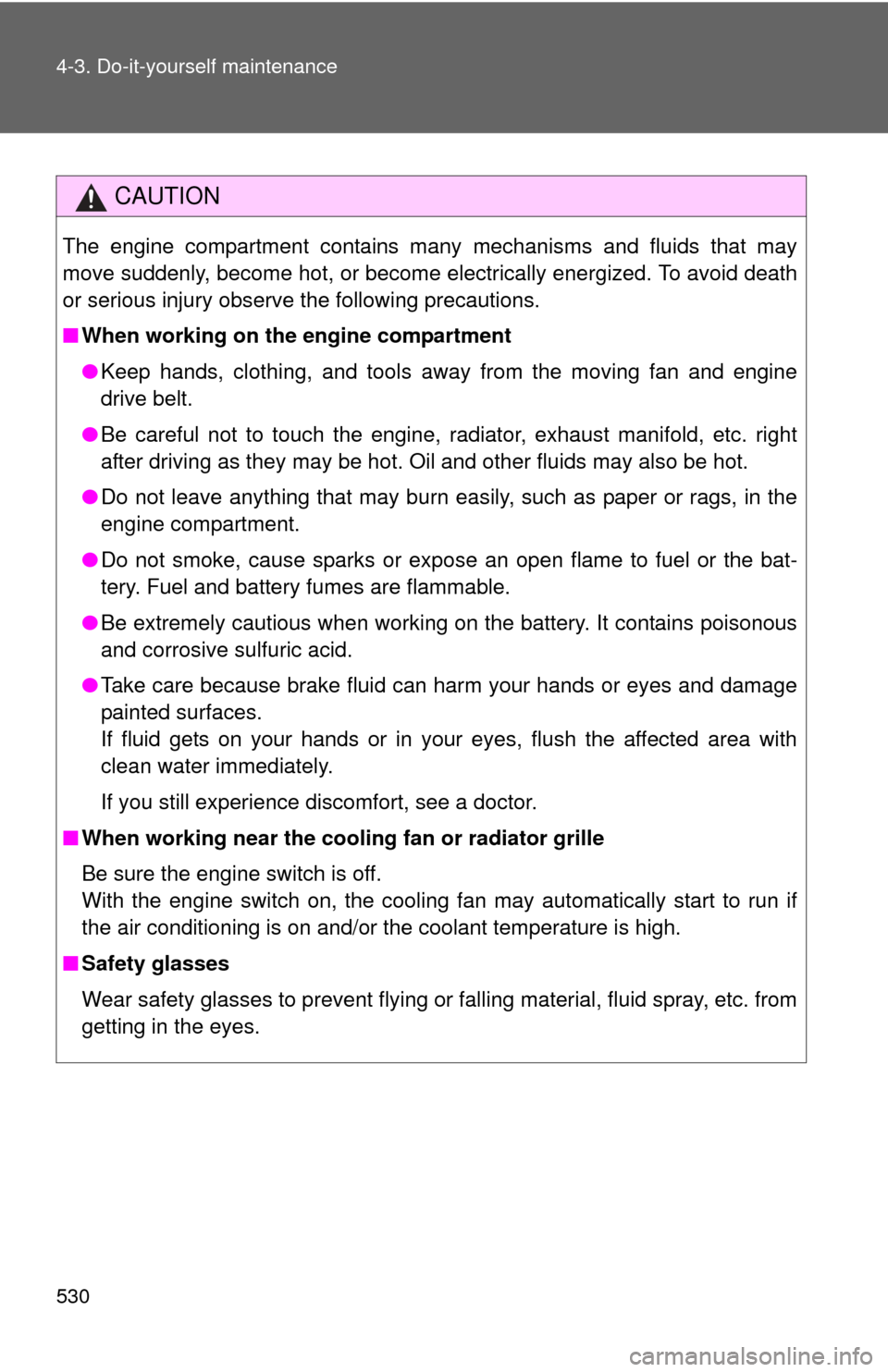
530 4-3. Do-it-yourself maintenance
CAUTION
The engine compartment contains many mechanisms and fluids that may
move suddenly, become hot, or become electrically energized. To avoid death
or serious injury observe the following precautions.
■When working on the engine compartment
●Keep hands, clothing, and tools away from the moving fan and engine
drive belt.
● Be careful not to touch the engine, radiator, exhaust manifold, etc. right
after driving as they may be hot. Oil and other fluids may also be hot.
● Do not leave anything that may burn easily, such as paper or rags, in the
engine compartment.
● Do not smoke, cause sparks or expose an open flame to fuel or the bat-
tery. Fuel and battery fumes are flammable.
● Be extremely cautious when working on the battery. It contains poisonous
and corrosive sulfuric acid.
● Take care because brake fluid can harm your hands or eyes and damage
painted surfaces.
If fluid gets on your hands or in your eyes, flush the affected area with
clean water immediately.
If you still experience discomfort, see a doctor.
■ When working near the cooling fan or radiator grille
Be sure the engine switch is off.
With the engine switch on, the cooling fan may automatically start to run if
the air conditioning is on and/or the coolant temperature is high.
■ Safety glasses
Wear safety glasses to prevent flying or falling material, fluid spray, etc. from
getting in the eyes.
Page 539 of 732
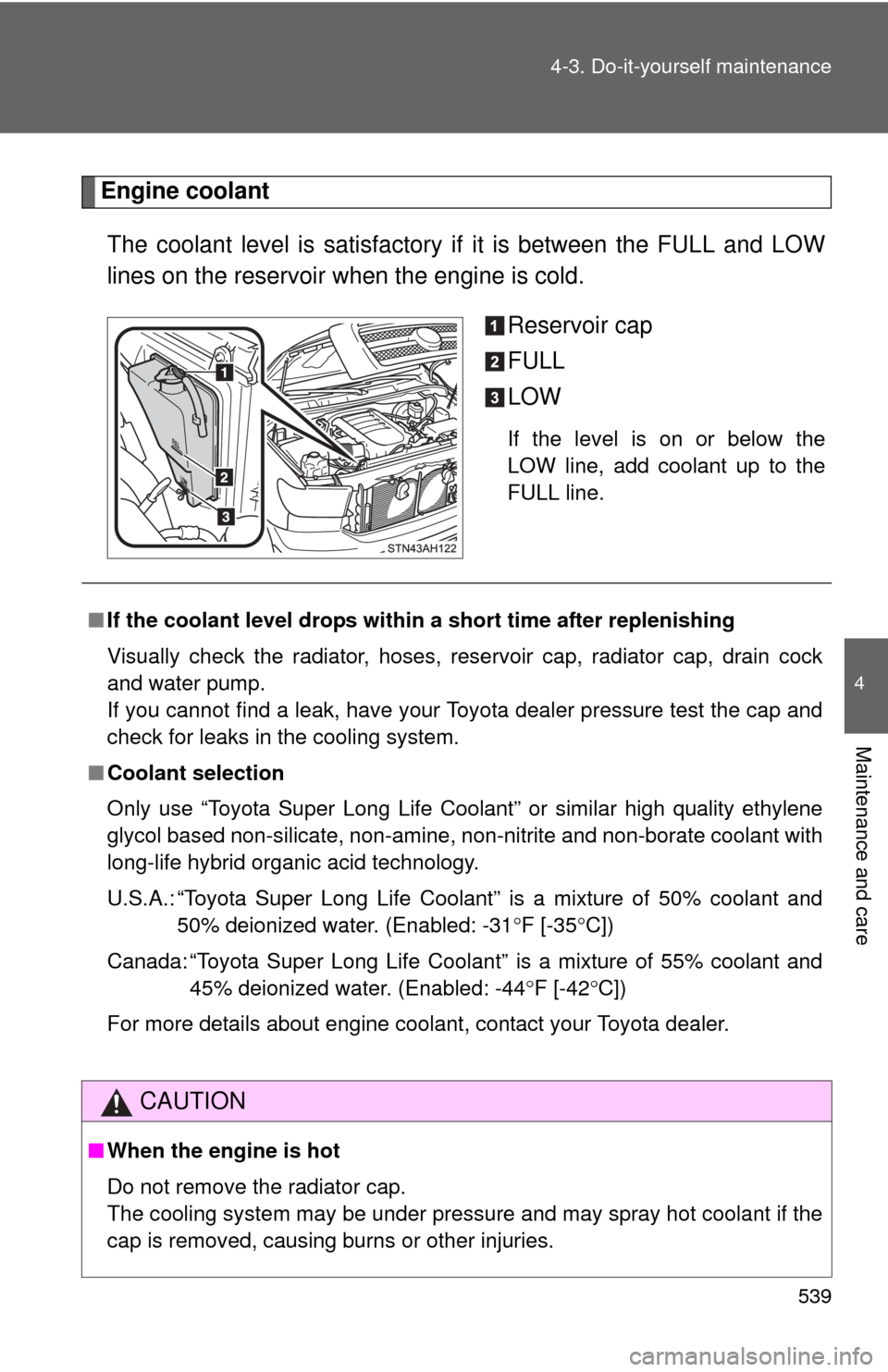
539
4-3. Do-it-yourself maintenance
4
Maintenance and care
Engine coolant
The coolant level is satisfactory if it is between the FULL and LOW
lines on the reservoir when the engine is cold.
Reservoir cap
FULL
LOW
If the level is on or below the
LOW line, add coolant up to the
FULL line.
■If the coolant level drops within a short time after replenishing
Visually check the radiator, hoses, reservoir cap, radiator cap, drain cock
and water pump.
If you cannot find a leak, have your Toyota dealer pressure test the cap and
check for leaks in the cooling system.
■ Coolant selection
Only use “Toyota Super Long Life Coolant” or similar high quality ethylene
glycol based non-silicate, non-amine, non-nitrite and non-borate coolant with
long-life hybrid organic acid technology.
U.S.A.: “Toyota Super Long Life Coolant” is a mixture of 50% coolant and 50% deionized water. (Enabled: -31 F [-35 C])
Canada: “Toyota Super Long Life Coolant” is a mixture of 55% coolant and 45% deionized water. (Enabled: -44 F [-42 C])
For more details about engine coolant, contact your Toyota dealer.
CAUTION
■ When the engine is hot
Do not remove the radiator cap.
The cooling system may be under pressure and may spray hot coolant if the
cap is removed, causing burns or other injuries.
Page 540 of 732
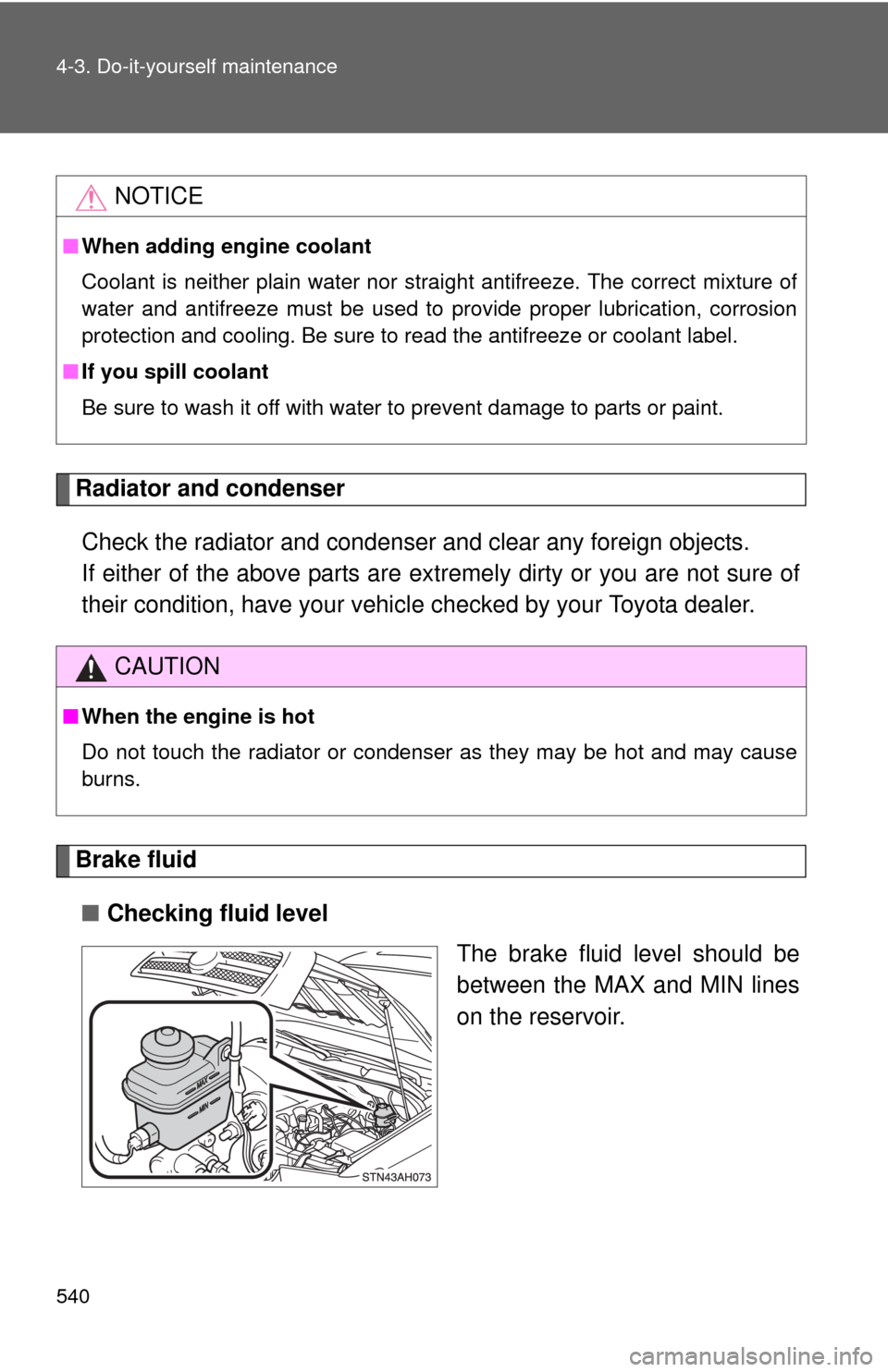
540 4-3. Do-it-yourself maintenance
Radiator and condenserCheck the radiator and condenser and clear any foreign objects.
If either of the above parts are ex tremely dirty or you are not sure of
their condition, have your vehicl e checked by your Toyota dealer.
Brake fluid
■ Checking fluid level
The brake fluid level should be
between the MAX and MIN lines
on the reservoir.
NOTICE
■When adding engine coolant
Coolant is neither plain water nor stra ight antifreeze. The correct mixture of
water and antifreeze must be used to provide proper lubrication, corrosion
protection and cooling. Be sure to read the antifreeze or coolant label.
■ If you spill coolant
Be sure to wash it off with water to prevent damage to parts or paint.
CAUTION
■When the engine is hot
Do not touch the radiator or condenser as they may be hot and may cause
burns.
Page 636 of 732
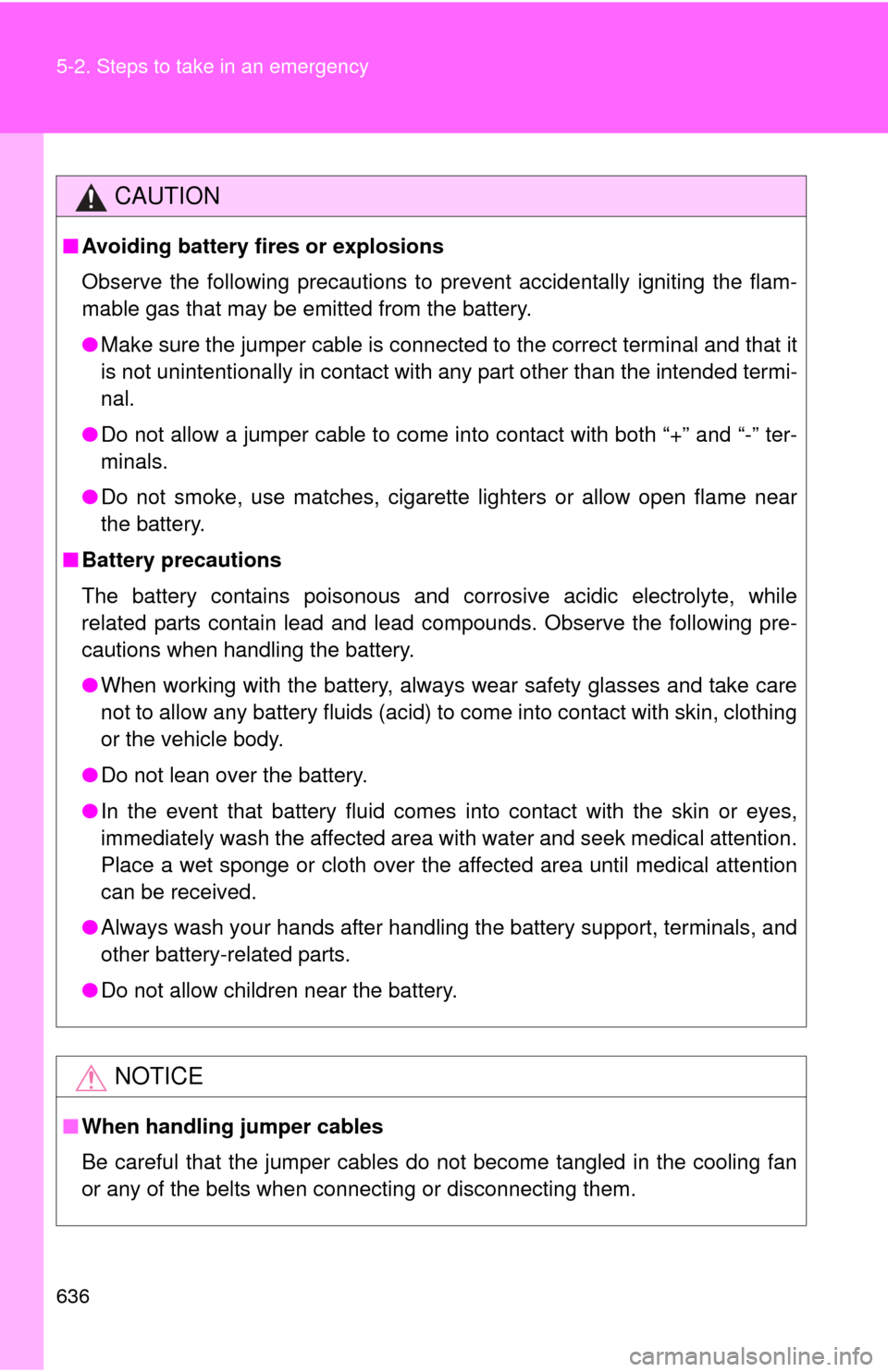
636 5-2. Steps to take in an emergency
CAUTION
■Avoiding battery fires or explosions
Observe the following precautions to prevent accidentally igniting the flam-
mable gas that may be emitted from the battery.
●Make sure the jumper cable is connected to the correct terminal and that it
is not unintentionally in contact with any part other than the intended termi-
nal.
● Do not allow a jumper cable to come into contact with both “+” and “-” ter-
minals.
● Do not smoke, use matches, cigarette lighters or allow open flame near
the battery.
■ Battery precautions
The battery contains poisonous and corrosive acidic electrolyte, while
related parts contain lead and lead compounds. Observe the following pre-
cautions when handling the battery.
●When working with the battery, always wear safety glasses and take care
not to allow any battery fluids (acid) to come into contact with skin, clothing
or the vehicle body.
● Do not lean over the battery.
● In the event that battery fluid comes into contact with the skin or eyes,
immediately wash the affected area with water and seek medical attention.
Place a wet sponge or cloth over the affected area until medical attention
can be received.
● Always wash your hands after handling the battery support, terminals, and
other battery-related parts.
● Do not allow children near the battery.
NOTICE
■When handling jumper cables
Be careful that the jumper cables do not become tangled in the cooling fan
or any of the belts when connecting or disconnecting them.
Page 637 of 732
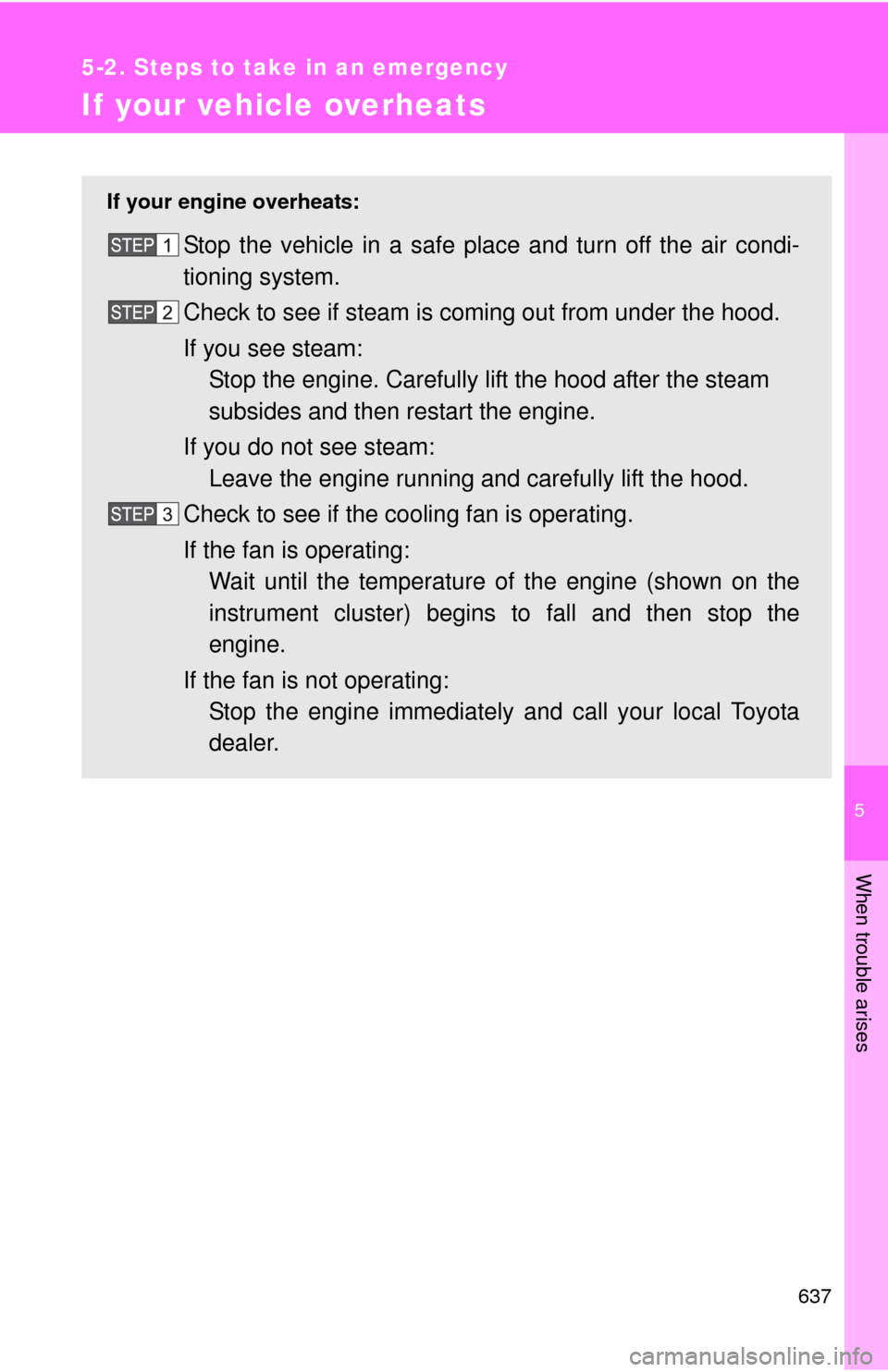
5
When trouble arises
637
5-2. Steps to take in an emergency
If your vehicle overheats
If your engine overheats:
Stop the vehicle in a safe place and turn off the air condi-
tioning system.
Check to see if steam is coming out from under the hood.
If you see steam: Stop the engine. Carefully lift the hood after the steam
subsides and then restart the engine.
If you do not see steam: Leave the engine running and carefully lift the hood.
Check to see if the cooling fan is operating.
If the fan is operating: Wait until the temperature of the engine (shown on the
instrument cluster) begins to fall and then stop the
engine.
If the fan is not operating: Stop the engine immediately and call your local Toyota
dealer.
Page 660 of 732
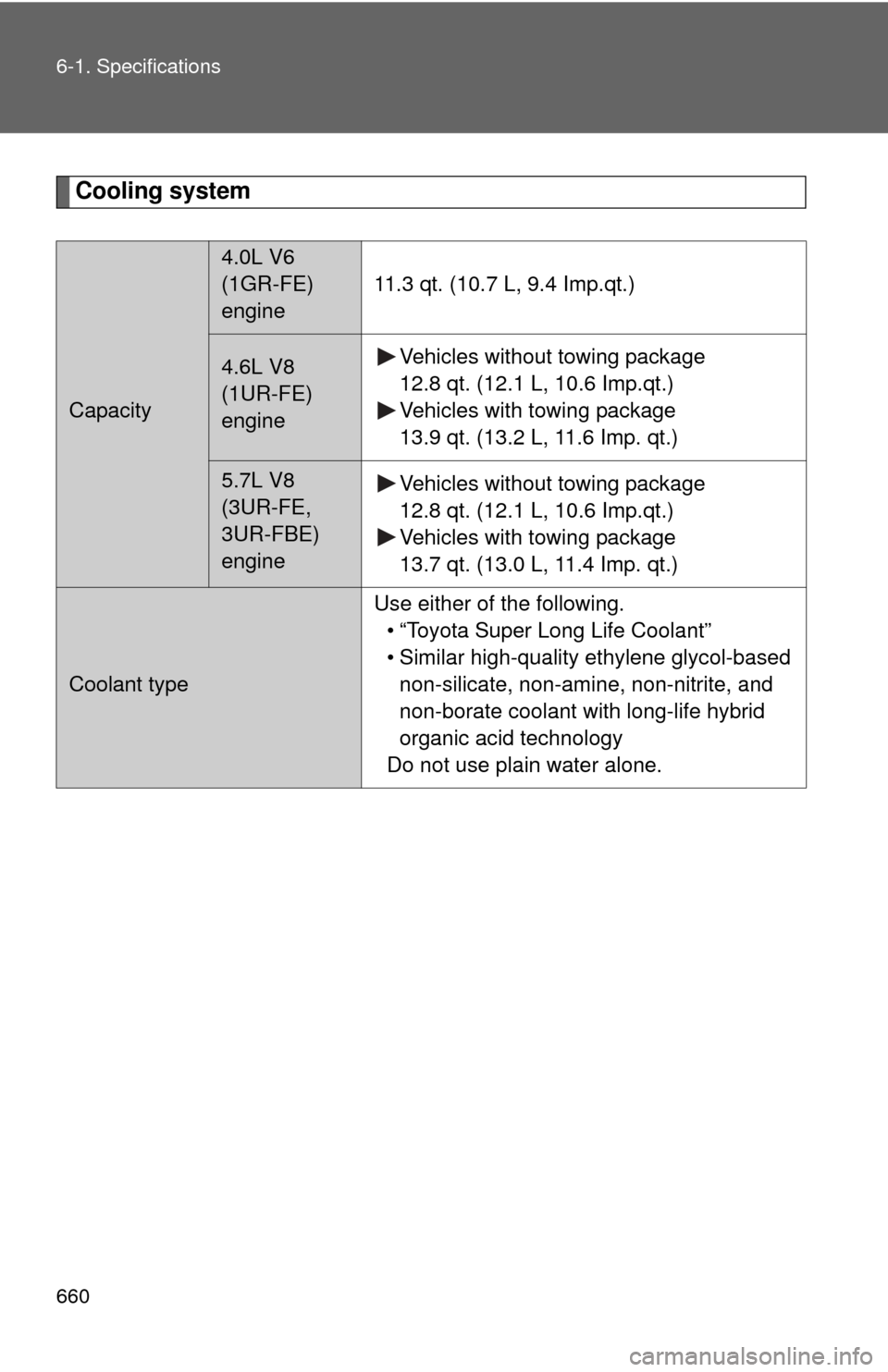
660 6-1. Specifications
Cooling system
Capacity
4.0L V6
(1GR-FE)
engine11.3 qt. (10.7 L, 9.4 Imp.qt.)
4.6L V8
(1UR-FE)
engine Vehicles without towing package
12.8 qt. (12.1 L, 10.6 Imp.qt.)
Vehicles with towing package
13.9 qt. (13.2 L, 11.6 Imp. qt.)
5.7L V8
(3UR-FE,
3UR-FBE)
engineVehicles without towing package
12.8 qt. (12.1 L, 10.6 Imp.qt.)
Vehicles with towing package
13.7 qt. (13.0 L, 11.4 Imp. qt.)
Coolant type Use either of the following.
• “Toyota Super Long Life Coolant”
• Similar high-quality ethylene glycol-based non-silicate, non-amine, non-nitrite, and
non-borate coolant with long-life hybrid
organic acid technology
Do not use plain water alone.
Page 720 of 732

720 Alphabetical index
Seat heater precautions ................. 493, 495
Child-protectors .........................49
Cleaning Exterior .................................. 516
Interior ................................... 519
Seat belts .............................. 520
Clock ........................................ 480
Compass ................................... 510
Condenser ................................ 540
Console box ............................. 455
Cooling system
Engine overheating ............... 637
CRS ........................................... 142
Cruise control........................... 220
Cup holders .............................. 468
Curtain shield airbags ............. 119
Customizable features..... 205, 683
Daytime running light
system .................................... 214
Deck hooks ............................... 500
Defogger
Back window ......................... 311
Side mirrors ................... 309, 311
Dimension................................. 644
Dinghy towing .......................... 288
Display Trip information ..................... 203
Warning message ................. 608
Do-it-yourself main tenance..... 528
Doors Door glasses ...........................94
Door lock ...........................44, 47
Open door warning........601, 609
Side doors ...............................47
Side mirrors .............................89
Driver’s seat belt reminder buzzer ..................................... 601
Driver’s seat belt
reminder light......................... 601 Driving
Break-in tips .......................... 173
Correct posture ..................... 117
Driving assist systems .......... 243
Procedures............................ 172
Winter driving tips ................. 261
Driving position memory .......... 68
DVD player................................ 390
Emergency flashers................. 588
Emergency flashers switch .... 588
Emergency, in case of Blown fuse ............................ 565
If the engine will not start ...... 628
If the shift lever cannot be shifted ................................. 630
If the vehicle has discharged battery .............. 634
If the warning buzzer
sounds ................................ 599
If the warning light turns on........................................ 599
If the warning message is displayed ......................... 608
If you have a flat tire ............. 612
If you lose your keys ............. 633
If you think something is wrong .............................. 595
If your vehicle becomes stuck ................................... 640
If your vehicle has to be
stopped in an emergency ... 641
If your vehicle needs to be towed ............................. 589
If your vehicle overheats ....... 637
Engine Compartment ........................ 533
Engine switch ........................ 181
Exhaust gas .......................... 178
Hood ..................................... 532
How to start the
engine ................................. 181
Identification number............. 655
D
E